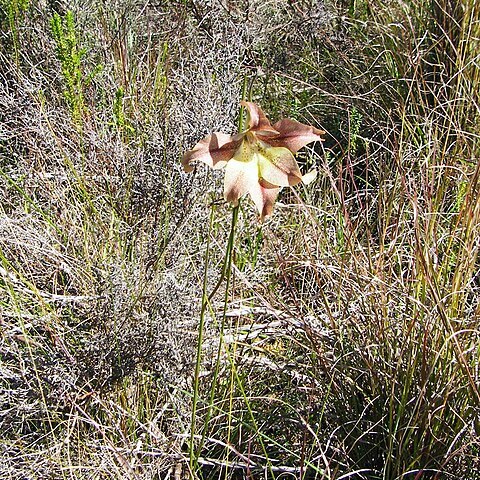Plants 300-800 mm high. Corm globose, 12-18 mm diam.; tunics ± woody to leathery, splitting below into claw-like segments. Stem usually inclined below, sharply flexed outward above sheathing part of uppermost leaf and strongly inclined above, unbranched. Leaves 3, overlapping, 2 lowermost basal, lowermost markedly longest, reaching to between base and shortly beyond apex of spike, sheathing lower part of stem or only near base, second leaf sheathing lower 1/2 of stem, linear, (1.5-)2.0-4.0(-6.0) mm wide, margins and midribs strongly thickened and raised, thus with two narrow or broad grooves or furrows on each surface, margin and main vein edges minutely scabrid, uppermost leaf inserted between middle and upper 1/4 stem. Spike inclined, lightly flexuose, 1-to 4(6)-flowered; bracts pale green or suffused dull grey, outer 55-80(-115) mm long, long-attenuate and often twisted above, especially lowermost, lower margins united around spike axis, inner shorter, twisted around to lie against outer, forked. Flowers light brown to dull pinkish red, tan, purplish or cream-coloured to greenish yellow, tepals darker along midlines, lower tepals pale yellow to cream-coloured in lower 1/3, abaxial 1/2 of throat speckled with dark brown, lower edges of dorsal tepal and sutures between tepals transparent, entire perianth changing colour after dark, becoming bluish to mauve and then intensely sweetly clove-scented; perianth tube narrowly and obliquely funnel-shaped, 40-45(-53) mm long, wider upper part 12-20 mm long, exserted between bracts, sometimes lightly pubescent in lower part of tube; tepals lanceolate-attenuate, slightly twisted in upper 1/2, margins undulate, sometimes crisped distally, dorsal largest, strongly inclined over stamens, curving upward distally, 38-45 x 14-20 mm, upper laterals 37-44 x 10-15 mm, arching outward from base, lower 3 tepals joined to upper laterals for 3-6 mm and sometimes together for up to 2 mm, curving outward distally, 31-40 x 10-15 mm. Filaments 15-25 mm long, usually exserted 1.5-5.0 mm from tube or sometimes only reaching top of tube, lightly pubescent below; anthers 11-16 mm long, brown or dull purple; pollen pale yellow or cream-coloured. Style arching over stamens, usually dividing opposite anther apices, branches ± 3 mm long. Capsules oblong-ellipsoid, triangular in section, 30-50 mm long. Seeds 4-5 x 3.0-3.5 mm, broadly and evenly winged.
More
Perennial herb, geophyte, 0.35-0.70 m high; corm globose, tunics ± woody to coriaceous layers; stem erect or inclined, simple. Leaves 3, linear, (1.5-)2.0-4.0(-6.0) mm wide, margins and midrib thickened, scabrid. Bracts pale green, long-attenuate, twisted above. Inflorescence a 1-4(-6)-flowered spike, inclined, lightly flexuose; flowers light brown, dull pinkish, red, tan, purplish or cream-coloured to greenish yellow; tepals darker along midlines, lower tepals pale yellow to cream-coloured below; perianth tube narrowly and obliquely funnel-shaped, pubescent below; tepals lanceolate-attenuate, twisted above, margins undulate, crisped apically, the dorsal largest. Stamens exserted; pubescent below; anthers brown or dull purple, nearly horizontal; pollen pale yellow or cream-coloured. Ovary oblong; style arching over stamens, pubescent below. Flowering time Sept.-Jan. Capsule oblong-ellipsoid.
Cormous geophyte, 35-70 cm, tunics woody. Leaves linear with thickened margins and midribs, bracts attenuate. Flowers long-tubed, funnel-shaped, brown to russet or beige, turning mauve in the evening and then fragrant.

